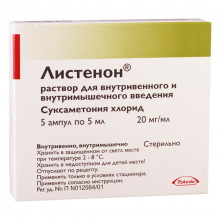



Lystenon has a muscle relaxant effect.
Causes blockade of neuromuscular transmission. During phase I, suxametonium chloride interacts with n-cholinergic receptors and causes depolarization of the end plate.
The process extends to the adjacent membranes, causing a generalized disorganized contraction of motor units of the muscles. Since acetylcholine is not metabolized in the synapse with sufficient efficiency, the membranes remain depolarized and do not respond to additional impulses. Since the maintenance of muscle tone requires the arrival of repeated impulses associated with the repolarization of the end plate, spastic paralysis occurs.
During phase II, with continued contact with suxametonium chloride, the membrane is not capable of new depolarization under the action of acetylcholine. The mechanism of this process remains unclear.
After the administration of Suxamethonia Chloride, myorelaxation occurs in the following sequence: the muscles of the fingers, eyes, legs, neck, back; then the intercostal muscles and diaphragm.
Suxametonium chloride is rapidly destroyed by blood pseudo-cholinesterase, which limits the intensity and duration of the neuromuscular blockade.
Does not penetrate intact BBB, data on the direct effect on cerebral functions are not available. In this case, suxamethonia chloride causes an indirect EEG activation, an increase in cerebral blood flow and intracranial pressure in conditions of weak general anesthesia.
After the on / in the introduction of the action develops in 54-60 seconds, after the / m - in 2-4 minutes.
Duration of action - up to 10 minutes.
Conditions requiring a short-term relaxation of skeletal muscles, including:
1 ampoule with 5 ml of isotonic aqueous solution for injection contains Suxamethonium chloride 100 mg
No customer reviews for the moment.
Intravenous bolus or as an infusion, intramuscularly. For long-term drip infusion, use 0.1% LISTENON® solution.
The dosage depends on the desired degree of muscle relaxation, body weight and individual sensitivity of the patient.
With the introduction of LISTENON® 0.1 mg / kg, skeletal muscle relaxation is observed without depressing respiratory function. A dose of 0.2 mg / kg to 1.0 mg / kg leads to complete relaxation of the muscles of the abdominal wall and skeletal muscles and, further, to limit or completely stop spontaneous breathing.
If intravenous administration is not possible, up to 2.5 mg / kg of body weight is administered intramuscularly, up to a maximum of 150 mg. The onset of muscle relaxation with intramuscular injection may be slightly delayed.
Children use only if absolutely necessary (see. Special instructions).
The dosage for children is: 1 - 2 mg / kg body weight intravenously or up to 2.5 mg / kg intramuscularly.
Intravenous drip: depending on the patient's body weight and the desired degree of muscle relaxation, the dose for adults is 0.5 mg - 5 mg / min in the form of a 0.1-0.2% solution.
LISTENON® is compatible with 0.9% sodium chloride solution, Ringer's solution, 5% dextrose solution and 6% dextran solution.
There is information about cases of irreversible cardiac arrest after the use of suxamethonia chloride in children and adolescents who had previously undetected neuromuscular diseases. Due to the danger of side effects, it is recommended to limit the use of suxamethonia chloride even in apparently healthy children and adolescents, except in those cases in which immediate intubation or release of the airways in critical situations is required.
LISTENON®, as well as all muscle relaxants of peripheral action, can be prescribed only by doctors who have experience with artificial respirators and skills in intratracheal intubation and in the presence of positive-pressure respirators that are ready for operation, as well as devices that provide sufficient oxygen and carbon dioxide removal .
To prevent severe bradycardia, bronchospasm or other muscarinic-like effects, before taking Lysthenon® Atropine is recommended.
Symptoms: increased severity of side effects, respiratory arrest.
Treatment: whole blood or canned plasma transfusion, artificial respiration with intermittent positive pressure. Translation to "double block" followed by neostigmine.